Written by Chris
During our time trekking in Nepal, we had the opportunity to walk paths through the Himalayas that have been in use for many, many centuries. Along these paths are many towns and structures just as old. One of the things that immediately endeared me to Nepal is how deeply religion was integrated into everyday life. Religious icons and structures were all over from the stupas placed on prominent mountaintops, to the temples and monasteries in towns, to the simple icons in the homes. Seeing these everywhere, we could not help but wonder what they all mean. I took to figuring some of it out and ended up becoming a bit of an amateur symbologist myself (take that Robert Langdon).
Where we were in the northern part was primarily Buddhist partly because Hinduism migrating from the south had not come this far yet and partly because of the many Buddhist refugees from Tibet who had moved into this area. As such, the symbols we saw were primarily Buddhist in origin.
Om mani padme hum
Om mani padme hum is THE sacred incantation of Buddhism. We saw it everywhere on artwork, carved in stones, and on everyday objects like bowls. I have seen it translated as something like, “the jewel at the heart of the lotus” but I also saw so many other translations that I tend to think it is more like some sort of basic untranslatable phrase. It is the bread and butter of any Buddhist prayer, and if you really want to get down while praying check out the soundtrack. We heard this playing in about 1/3 of the shops and restaurants in Nepal and the track really is 24 minutes long. And they loop it.
Prayer flags
Prayer flags are another thing you see everywhere in Nepal. They are strung across homes and businesses, over the streets, from trees, and especially on mountains where the endangered traveler needs that little extra boost of prayer. The flags are typically colored squares of cloth hung from a string and printed with a variety of prayers. The thinking goes that as these flags flap in the wind, the prayers on them are flung off into the heavens. Hang one of these, and you can pray all day with minimal effort. The flags are in five colors representing the 5 elements; blue (sky), white (air/wind), red (fire), green (water), and yellow (earth).
Mani stones
When you really want to send out a prayer in Nepal, you carve it into a stone. They call these inscribed stones mani stones and they are often piled together on or along a wall (mani wall). Some of the walls we saw were hundreds of years old as were the prayers at the bottom of the pile. Often, they are carved with an Om mani padme hum but they can also have very long and detailed prayer text.
Prayer wheels
The prayer wheels are cylinders inscribed on the outside with prayers. When spun, they fling the prayers out to the heavens similar to the prayer flags. They say that spinning a prayer wheel is equivalent to chanting the prayer 100 times. We often saw long walls embedded with them to spin as you walk past (as in the post’s title image) or giant ones in towns and monasteries. You can even get a small solar-powered wheel for your car’s dashboard to spin and pray for you endlessly.
Stupa
A Stupa is a structure built as a religious icon. They are typically only for decoration and prayer but they occasionally hold the remains of an important Buddhist holy figure. They range in size from knee-high to 50 feet or more, are usually painted white, and are always placed in a place of prominence. Most hilltops have one, they are all over towns and especially and the gates to give good fortune to those traveling.
Buddha
The founder of Buddhism is usually given this representation. You will always see a statue in the central prayer area of the monasteries (or more often 3 statues representing the past, present, and future Buddha). The fat, jolly Buddha representation we often see in the west is a different buddha (there have been many buddhas, or enlightened ones) but this one, Siddhārtha Gautama Buddha, was the first Buddha.
Buddha eyes
The Buddha eyes appear on many large stupas in Nepal, but it also a very common symbol all over. Like on t-shirts common. The eyes represent the wise and all-seeing eyes of Buddha, the curly-que nose is actually the Nepal character for the number 1 (unity of all things), and the swirl in the middle represents the third eye (perception beyond sight).
Ringsum Gonpo
This was a common arrangement often on the gateways to towns; the 3 different colored stupa configuration known as a Rigsum Gonpo. The red is for wisdom, the white for compassion, and the black/blue/gray fights evil. Together they can protect from evil from the three realms; sky, earth, and underworld. Interestingly, they seem to be providing this protection while their weight is straining ancient supports that you walk under. Adventure!
Mandala
A mandala is typically a circular painting with a prayer inscription on it. It is used to aid in meditation to give something to focus on. Most monasteries had at least one of these painted on the wall. Buddhist teachings say that creating a mandala painting moves one towards enlightenment; and higher quality gets you there faster.
Swastika
It was quite shocking at first to see swastikas all over the place in Nepal; even more so when you realize that they have an active communist party in the country. However, it turns out that the swastika is an ancient symbol of success or good fortune to most Buddhists and Hindus. Also, archaeologists have found the symbol inscribed on pieces dating back as far as 10,000 BC! It wasn’t until the 1920’s that is was adopted as the symbol of the Nazi Party in Germany. As a result of their antics, it has largely been eradicated from western culture.
Varja
The name means “thunderbolt” or “diamond” in Sanskrit. It is a device used in Buddhist meditation as yet another way to train one’s focus. So the name is intended to invoke spiritual power and strength. In addition to the handheld versions of various sizes, they are also often represented in sculptures or artwork in monasteries and temples.
108
The number 108 is a sacred number around these parts, though there is not a strong consensus as to why. Often, places of significance would exhibit this number in some way; 108 water faucets, 108 prayer wheels, 108 decapitated animals during the festival of Dasain (darn, we just missed it). Perhaps it is the mathematical signifigance; 9 dozen, 1x2x2x3x3x3, among many others.
The Hexagram
The hexagram, or six-pointed star, is a symbol common to both Judaism (Star of David) and Buddhism. It is not clear if the symbol is shared due to common origins or if it is simply coincidence. Buddhists and Hindus view this symbol as a representation of the union between male and female and of creation itself.
Footprints of Buddha
We often saw people in temples touching their foreheads to a pair of feet on the ground and, it turns out, they were just worshiping Buddha. The footprints of Buddha (Buddhapada) are highly revered both as a symbol of Buddha’s presence (Buddha was here) and also of his absence (footprints are all that remain now that he is off to nirvana). Sort of surprising in a part of the world where feet are often considered unholy and the highest insult is to hurl a shoe at someone. But when it comes to the Buddha, it’s all good.
Marigolds
Marigold flowers are seen all over Nepal; grown in gardens, left as offerings in temples, and made into garlands and strung about for all manner of occasions. They just see them as an object of beauty and for good luck.
Lucky us!
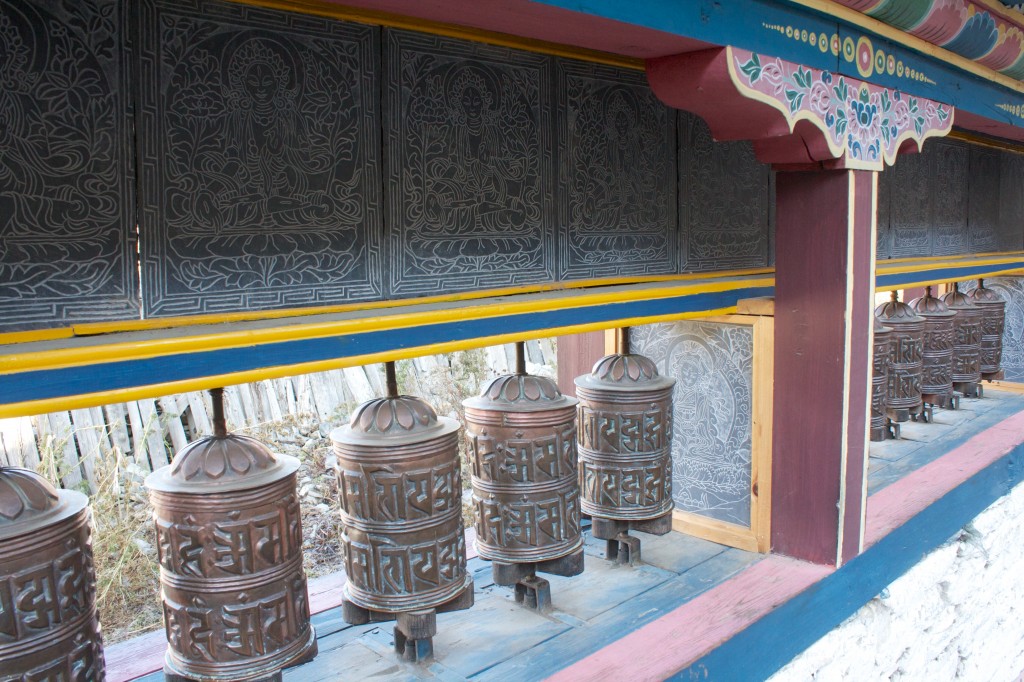
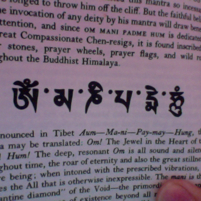
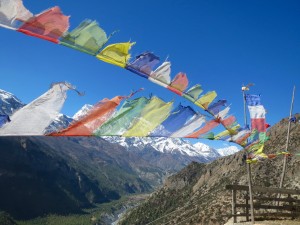
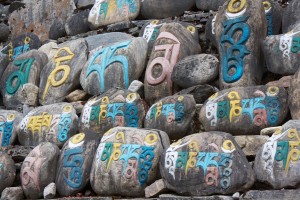
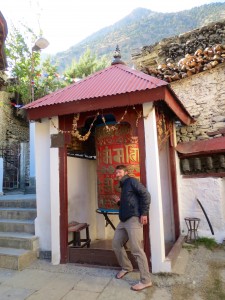
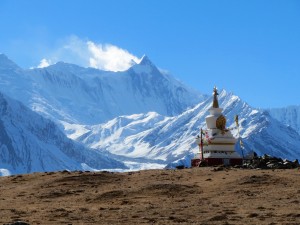
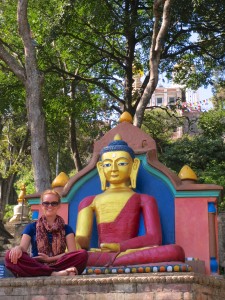
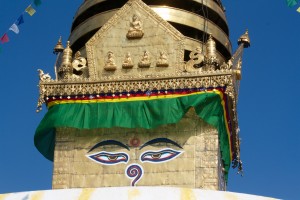
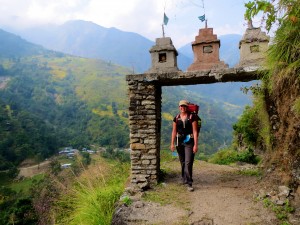
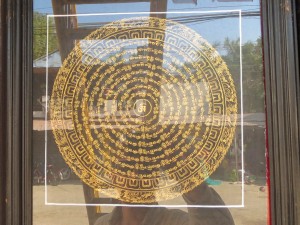
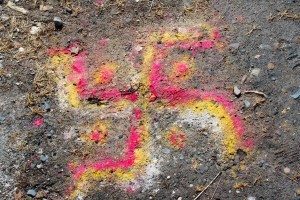
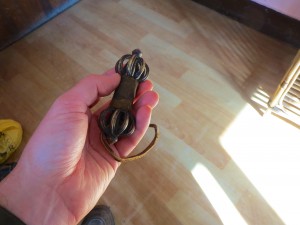
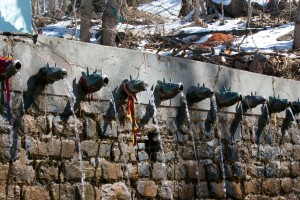
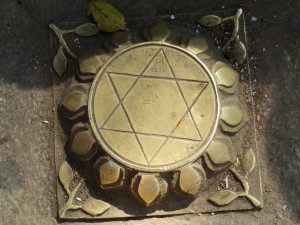

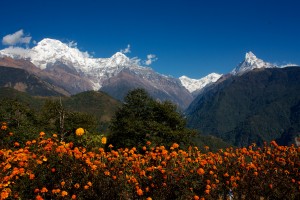
Comments are closed.